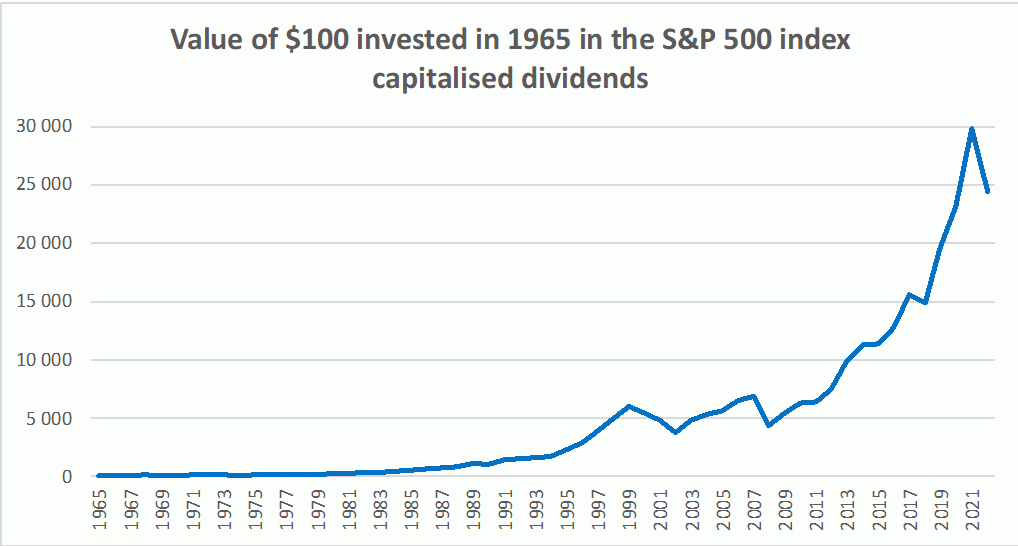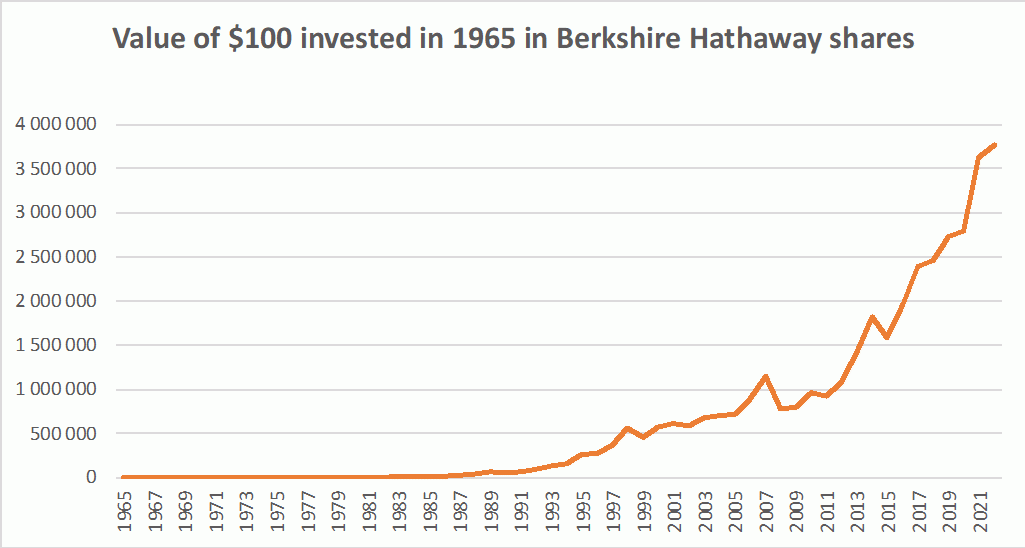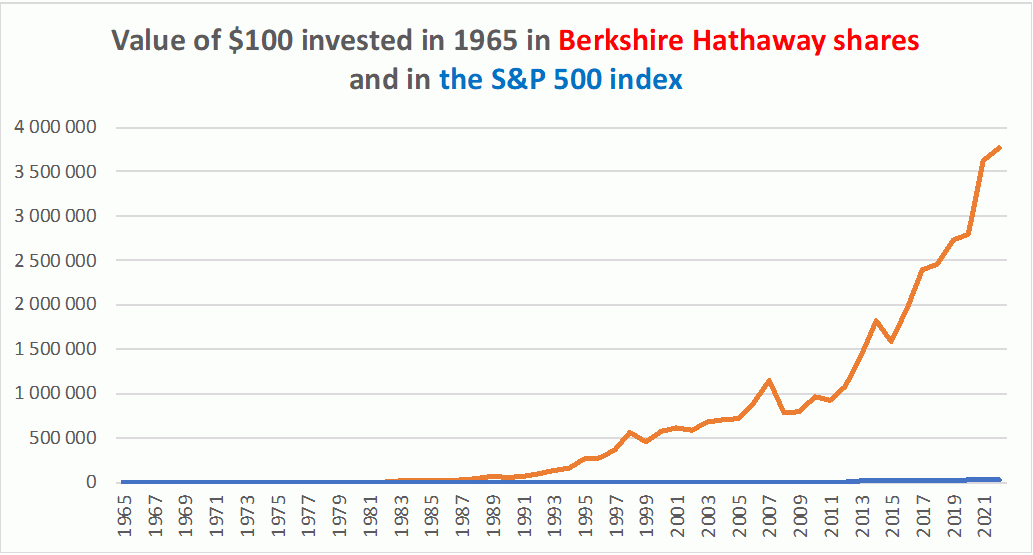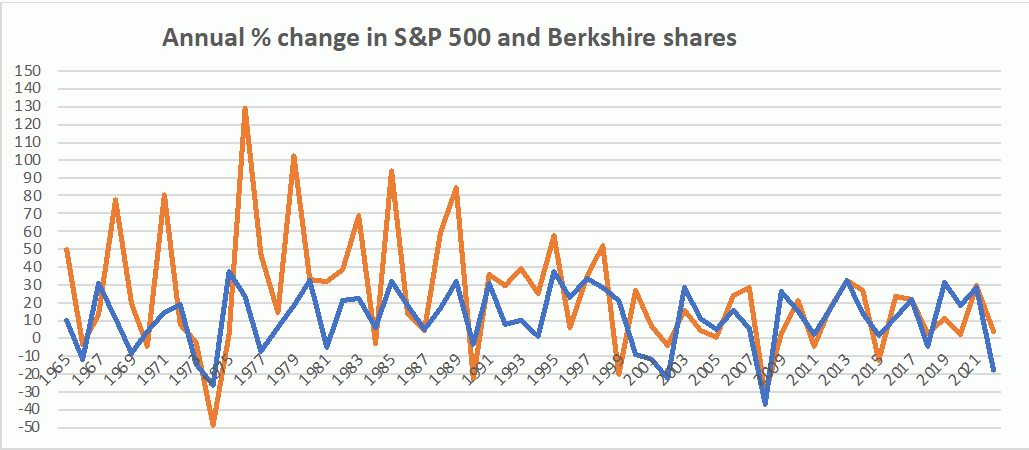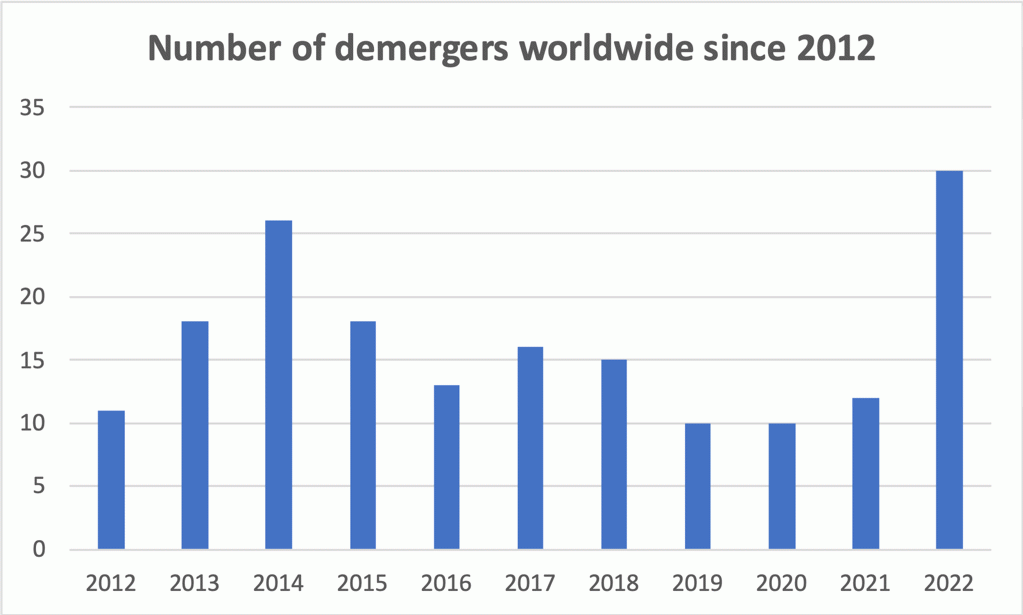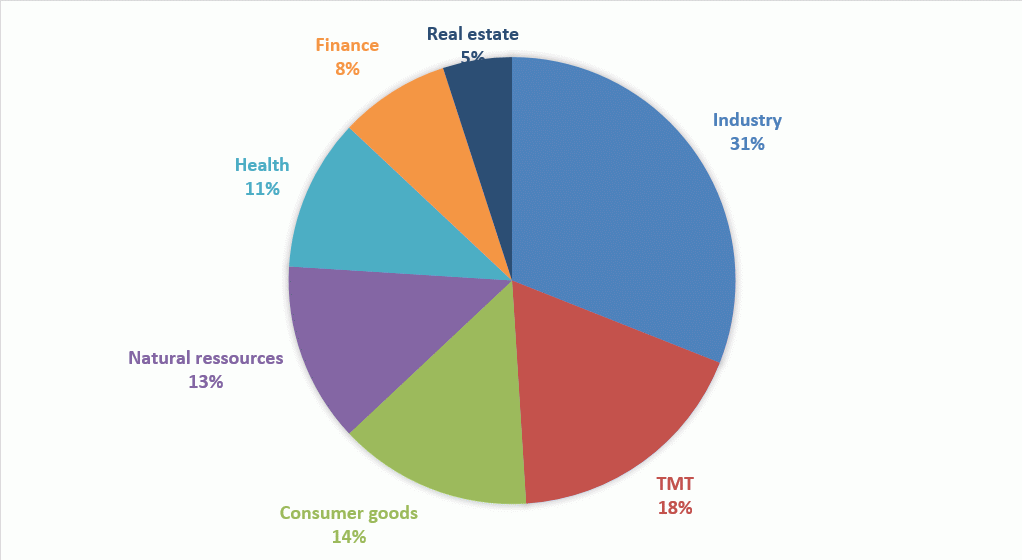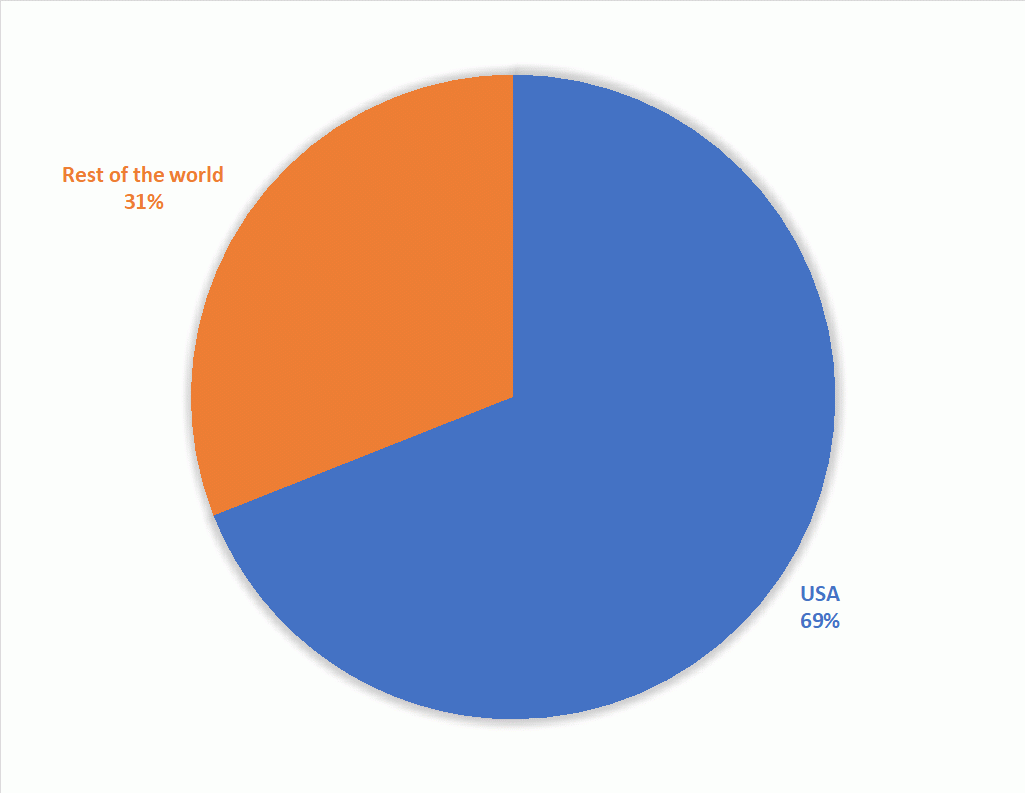Letter number 153 of December 2023
- TOPIC
- STATISTICS
- RESEARCH
- QUESTIONS & COMMENTS
- NEW
News : Does Berkshire Hathaway's management style explain its exceptional performance?
The exceptional performance of Warren Buffett's investment vehicle can be illustrated by 5 graphs.
Here's what would have happened to $100 invested in 1965 in the S&P 500 index, dividends reinvested as you received them:
Here's what would have happened to $100 you invested in Berkshire Hathaway in 1965, without reinvesting the dividends because there were none:
If you don't pay attention to the vertical scale, you might think there's not much difference. Big mistake! Over 58 years, Berkshire Hathaway shares have returned 20% a year, compared with 10% for the S&P 500 index. In the first case, you multiplied your investment by 37,779 (sic) and in the second by 244. This shows the power of compound interest over the long term (57 years in this case), especially when the investment is made in an American economy that has not experienced any of the life-threatening crises experienced by Russia (in 1917), China (in 1949), Germany (in 1923 and in 1945), Cuba (in 1959) and Lebanon.
It also shows Warren Buffett's exceptional talent, for the greater good of the investors who put their trust in him years ago, and also for the greater good of society in two ways.
Firstly, thanks to his activity, the capital entrusted to him has been well invested and not wasted on investments that it would have been better not to make. Over such a long period, such stock market performance cannot be achieved unless the companies in which Berkshire Hathaway has invested avoid wasting their capital on unwise investments. Let's not forget that capital does not in practice exist in infinite amounts, and that poor investments mobilise funds that could more often than not have been invested more wisely by other management teams in other companies. The judicious allocation of capital is the key to creating long-term value and avoiding relative or absolute impoverishment.
Secondly, because Warren Buffet redistributes a very substantial part of the wealth he has created to philanthropic causes, which also benefit society as a whole. His aim is to redistribute all his Berkshire Hathaway shares; to date he has donated around $50bn.
And his outperformance over time is best seen by superimposing the two previous curves in this one:
Yes, the S&P 500, which had risen by 10% a year over 58 years, has become virtually flat in relative terms.
In fact, while over time Berkshire Hathaway has delivered a return to its shareholders that is twice that of the market index, it has also delivered twice the volatility, which is understandable given that Berkshire Hathaway is naturally less diversified than the S&P 500. This is the result of a conscious and considered stock-picking strategy that produces results over time, not instantly. Berkshire Hathaway is not an ETF!
While over 58 years Berkshire Hathaway has produced a positive annual performance as many times as the S&P 500 index (47 times versus 45 times, which is not a significant difference), Warren Buffett's group has beaten the index 39 years out of 58. And when it did beat the index, it did so by a much greater amount than in the 19 years when it underperformed it: +26% compared with -15% in the years of underperformance.
Note that the annual performance gap has narrowed over time as Berkshire Hathaway has grown (it now represents 2% of the market capitalisation of the S&P 500). Adding assets to assets plays a similar role, as Berkshire Hathaway's policy of total reinvestment of earnings, excluding the payment of any dividend, increases the diversity of its assets, bringing them closer to the composition of the market index.
As a result, since the financial crisis of 2008, Berkshire Hathaway has ceased to outperform the S&P 500 index.
* * *
In this second part we will look not at how Berkshire Hathaway selects its investments - a subject on which Warren Buffett has written extensively, producing some famous aphorisms in the process - but at the group's management principles.
From the outside, the group is organised around three core businesses:
1/ The insurance business, which, because of its inverted cycle (with insured customers paying premiums before receiving any claims), generates outstanding cash ($166bn at 30 June 2023) which will be invested:
2/ In minority financial holdings (Apple, Bank of America, Amex, Coca-Cola, Occidental Petroleum, etc.);
3/ Or in fully controlled industrial or commercial companies, such as BNSF in railways, PacificCorp and Nevada Power Company in energy, but also HomeServices of America in real estate brokerage, Precision Castparts in aircraft equipment, Lubrizol in speciality chemicals, Clayton in house building, Shaw Industries in flooring, John Manville in thermal insulation, Acme in building materials, Fruit of the Loom in textiles, Duracell in batteries, NetJets in business aviation, International Dairy Queen in fast food, Candy Shops in confectionery, and so on.
It was Warren Buffett's partner who, last spring, gave his view of the group's management principles, which make it not a family financial holding company like GBL or Exor, not a private equity fund like Carlyle or CVC, not a conglomerate like Bouygues or Reliance, not a financial group like Paribas or Mediobanca were 40 years ago, but an animal quite unique in its organisation and performance.
Berkshire Hathaway is not a conglomerate, because it refrains from transferring the managers of its various holdings between them, unlike a conglomerate that thinks it can provide its divisions with management know-how in this way. At Berkshire Hathaway, when you're the boss of a division, it's for life, barring an accident. The weakness of its central teams is the best way of combating the risk of bureaucracy to which any organisation that grows in size is exposed, and which killed off the great conglomerates of the 1960s and 1970s (Schneider, ITT, Gulf and Western, GEC plc, Philips, etc.). At Berkshire Hathaway, the core team consists of a chairman (Warren Buffet), a vice-chairman (Charlie Munger until his recent death), a chief financial officer who produces the consolidated accounts, is responsible for internal control, management control, investor relations and... that's it.
All the other functions are in the industrial and commercial subsidiaries, which are therefore totally autonomous from a managerial point of view. In particular, the mergers and acquisitions departments are located in the subsidiaries, not at head office, which has no such department, because the idea is for these entities themselves to look at complementary acquisitions in each of their business lines that make sense, not at the centre. The centre simply takes the free cash flow from entities that no longer have sufficient opportunities for rational internal or external growth, and allocates the surplus capital to other entities in the group that have a shortage of capital but no projects, or to new acquisitions or investments.
In the same vein, there is no system of profit-sharing for group staff; each entity manages its own, with no intra-group pooling.
Warren Buffett, in addition to deciding on takeovers and major stock market investments, focuses on the choice of managers, using a few common-sense principles: choose those elected on the basis of the trust you can place in them and their honesty, energy, knowledge and love (yes, love) of their sector.
The emphasis placed on the long term and the accountability of the managers of the main subsidiaries, carefully chosen by Warren Buffett, means that a talented manager in the group will never be pushed into retirement on the grounds of age, nor will another be promoted on the basis of seniority. But having talented managers over the long term makes all the difference. In France, for example, Nicolas de Tavernost, COO and then CEO of M6 since 1990, a television channel considered at the time to be one too many, has now, 35 years on, overtaken the arch-leader TF1, to the point of being able to take it over if the antitrust authorities had not got in the way. Or L'Oréal since 1948, with François Dalle, Lindsay Owen-Jones and Jean-Paul Agon, each holding the position of CEO or chairman for an average of 27 years.
Berkshire Hathaway is not a financial holding company because it owns 100% of its industrial and commercial subsidiaries, rather than a minority stake, based on the principle that if you believe in the value of an asset and its management team, it is better to own 100% than 15% or 25% like Exor or Wendel. Similarly, Berkshire Hathaway rarely sells subsidiaries. As with the management of minority shareholdings, Berkshire Hathaway's approach is to buy and hold, confident in the depth of its pre-investment analysis and in its choice of the men and women who will manage them.
Berkshire Hathaway's reluctance to sell its industrial and commercial assets and its 100% ownership of its assets mean that its net income is less volatile and much more relevant. This is because the earnings of subsidiaries are measured at 100% and not through dividends, which are either confiscatory for the entities and lead to under-investment, or reflect only part of their earnings, leading sooner or later to the sale of these subsidiaries to extract the value created. In this way, investors can value Berkshire Hathaway on the basis of a multiple of current profit after tax. This avoids the mortal wound of a financial holding company, i.e. valuation by investors on the basis of net asset value, which sooner or later will inevitably be subject to an unavoidable discount.
For example, Berkshire Hathaway's market capitalisation currently exceeds its consolidated book equity by 55% ($733bn vs. $472bn), compared with discounts of between 20% and 60% for holding companies (Wendel and GBL are at a one-third discount to book equity, and even more to net asset value). The P/E on earnings over the last 12 months is 22.7.
Berkshire Hathaway is not a private equity group either, because it is allergic to debt, believing that the availability of cash is a major strategic asset that enables it to seize opportunities in the inevitable crisis phases of the economic cycle that few can, at prices that build outperformance over time. It has the good fortune to benefit from long-term equity, the bulk of which has come from reinvesting its profits over the past 58 years, since no dividend has been paid out. And when it buys back shares, it does not need to sell assets to finance them, whereas private equity funds have to sell their holdings, usually after 10 or 12 years.
We conclude by quoting what Charlie Munger describes as the Berkshire Hathaway CEO's "first priority": "His first priority would be reservation of much time for quiet reading and thinking.” At a time when many people are constantly connected to their emails, text messages, LinkedIn, WhatsApp, Instagram, Facebook, TikTok accounts, not to mention their spreadsheets, this is a welcome reminder. So let's hear it!
Armed with this information, we leave you to answer the question that is the title of this article for yourselves.
Statistics : Demergers
Spin-offs are a small segment of the M&A market, with 179 deals worldwide since 2012, for a total value of just over $1,200bn:
All sectors are concerned:
with an overweighting of traditional sectors. But demerger is essentially an American phenomenon:
It is estimated that 10.7 months elapse between announcement and completion, and in our experience at least as much time is spent preparing for the announcement. This explains why the costs of the operation are not negligible, with a median of 3% of the value of the demerged entity, which on average grows its sales by 4.7% a year in the 2 years following the operation, compared with 0.4% for its former parent company.
Research : Recruiting directors: the role of personal networks
With Simon Gueguen, lecturer-researcher at CY Cergy Paris University
How are company directors recruited? As the old saying goes, "The best way to get on a Board is to know someone on a Board"[1]. The principle at a traditional company (in this case, we're interested in listed companies) is that the majority of directors defend the interests of shareholders. However, they are not directly chosen by shareholders. They vote on proposals emanating from the Board. When it comes to appointments though, we often see, if not cronyism, at least a previously existing relationship between the new director and a member of the Board. This practice is controversial. An article[2] looks at how to measure this phenomenon, with two goals. Firstly, to check that personal networks actually play a significant role in appointments, over and above a few high-profile cases. Secondly, to study the consequences for company valuations.
The empirical study focuses on the appointment of directors between 2003 and 2014 at US listed companies (nearly 10,000 appointments). Of the total sample, 29% of new directors have a direct professional connection with at least one of the other directors of the company. This result is significant for one simple reason: of all the directors listed in the United States, only 0.4% (according to the Boardex database, the benchmark in this area) had such a connection with the Board in question. If we consider second-degree connections (the director has worked with someone who has worked with a board member), the figure rises to 69%. The figure is even higher for SP500 companies: over 90% of appointments have a first- or second-degree connection compared with 21% in the base. On the other hand, non-professional networks (linked to studies or other social connections) seem to play a marginal role. So, it's not necessarily a question of cronyism, and Cai et al are interested in the rationality of the phenomenon.
On the one hand, choosing a new director from among your personal network can have its advantages. Research has shown that the fact of having already interacted professionally with this person favoured coordination. This can make it easier for the Board to take decisions, which most of the time seek consensus. This is the coordination hypothesis: the role of personal networks is positive because it reduces the costs of coordinating the Board. Another argument in favour relates to the recruitment process itself. It's easier to obtain reliable information about the quality of a candidate you already know, at least through an intermediary. Finding the perfect person outside personal networks takes more time and requires a more in-depth search to secure skills, without this additional expense necessarily translating into better recruitment. This is known as the search cost hypothesis. These two hypotheses would imply an increase in the value of the company when a network is relied on.
On the other hand, choosing from among members of networks runs the risk of adding to the homogeneity of skills on the Board. The new director selected in this way is more likely to share the approach and ideas of existing Board members. This encourages coordination, but it also reduces the ability to broaden perspectives, contribute new ideas or identify problems. This is known as the homophily hypothesis. More serious still is cronyism, which is mainly associated with the CEO network, with CEOs choosing members of their own networks in order to enjoy a free hand to act in their own interests, and which implies an agency problem (agency hypothesis).
Of the four hypotheses, only one does not appear clearly in the data, that of homophily. In many cases, professional networks are even used to recruit directors with a different specialism from other Board members. The procedure is therefore not unfavourable to diversity of skills. Generally speaking, the market reacts positively to the appointment of directors chosen from personal networks, and this is particularly the case in companies facing complex sector and competitive issues. The only negative effect (which only attenuates this trend) occurs when the network drawn from is that of the CEO. Rightly or wrongly, since the study focuses on instantaneous market reaction, investors consider that the choice of a director from among members of professional networks is judicious and a guarantee of quality, especially as the new director brings his or her own skills to the table. Only CEO cronyism is perceived negatively.
This study is important because it is probably the most comprehensive and well-documented on the role of networks in the director recruitment process. It shows that the use of these networks does not destroy value and that the problems of cronyism, while they exist and are widely publicised, should not lead to the systematic rejection of the use of personal networks.
Q&A : Value of a start-up and dilutive instruments
We have recently observed that some venture capital funds are valuing a start-up with a few years behind it by departing from the standards usually used to value dilutive instruments when valuing a company.
The market practice consists of either:
- deducting the value of dilutive instruments in the bridge from enterprise value to equity value;
- assuming that the dilutive instruments in the money are exercised and that the company uses the funds thus obtained to buy back some of the newly-created shares, with the balance diluting the value per share;
- or, in the investment of funds method, assuming that the funds resulting from the exercise generate financial income which increases net income and reduces the dilution of EPS due to the increase in the number of shares in circulation.
We agree that the method of investing funds is not appropriate in a situation where the company is still making a loss. However, there are still two methods which seem to us to be intellectually more honest than simply increasing the number of outstanding shares by those which may result from the exercise of dilutive instruments, while pretending to forget the funds contributed to the company which their exercise presupposes.
This is a particular disadvantage for a start-up that has recently set up a stock-option plan with an exercise price close to that of the share price. By way of illustration, let's take an equity value, before taking dilutive instruments into account, of €1,000, divided between 100 shares, i.e. €10 per share. There are 10 stock-options with an exercise price of €8. Exercising them will result in the company receiving €80, with which it could buy back 8 of the 10 newly created shares, leaving a balance of 2 new shares, which illustrates the cost of stock options to shareholders, and a value per share of €9.8.
The Praetorian method used by some funds leads to a value of €1,000 / (100 + 10) = €9.1, i.e. 7% less in this example, which is not a totally insignificant difference.
Since the Praetorian Guard was disbanded by Constantine in 313, we think it is time in 2023 to abandon its methods... even for funds which, compared with other funds investing at more advanced stages of a company's development, have a lower level of financial sophistication.
New : Comments posted on Facebook
Regularly on the Vernimmen.com Facebook page[1] we publish comments on financial news that we deem to be of interest, publish a question and its answer or quote of financial interest. Here are some of our recent comments.
Naming and shaming in Japan
Japan never ceases to amaze us. Eight months ago we commented on the relationship between Kyocera and KDDI, which is far from being marked by good governance.
This week, we learned that the Tokyo Stock Exchange will shortly officially publish the list of listed companies whose equity value is greater than their book value, i.e. whose PBR is greater than 1. Less than half of listed Japanese groups have a PBR greater than 1, compared with 60% in Paris. However, if a serious plan to remedy this situation has been announced, a Japanese group worth less than its book value could join the roll of honour. Phew!
Shame, of course, for those who remain outside this list! This will point out that they are indulging in a situation where the 100 invested by shareholders in the form of a capital increase or reinvested profits not paid out as dividends are worth less than 100. This is the hallmark of poor capital allocation, which penalises the economy as a whole because this capital, which does not exist in unlimited quantities, could have been devoted to more efficient management teams to carry out other projects. A PBR that is persistently below 1 may be the result of a return on assets that is persistently below the cost of capital, a particularly opaque group structure, a poor corporate governance, a financial structure with far too much debt, and so on.
In the United States and Europe, without the need to publish a list, it is the role of shareholder activists to try to change things. In Japan, where activist shareholders are not welcome, it is the Tokyo Stock Exchange that wants to encourage its listed company clients to improve, for the greater good of the users of its platform, the investors, and of society in general, by publishing a list of the next targets of activists.
The passing away of Charlie Munger
Charlie Munger, vice-chairman of Berkshire Hathaway, died on Tuesday evening a month and 4 days shy of his hundredth birthday, having still not retired, or even semi-retired.
We can't help thinking that hard intellectual work is good health, and that finance keeps those who practice it regularly!
Charlie Munger, a lawyer by training, is the man whose letter to the shareholders of Berkshire Hathaway inspired our news article of this month, which questioned the impact of Berkshire Hathaway's management style as the source of its exceptional performance.
Charlie Munger is the man who convinced Warren Buffett to change his investment strategy, as the latter admitted in 2005 in his letter to shareholders: "The blueprint he gave me was simple: forget what you know about buying fair businesses at wonderful prices; instead, buy wonderful businesses at fair prices".
In fact, in his early days, Warren Buffett invested in companies in great difficulty, and therefore cheap, such as Berkshire Hathaway, which was active in the textile sector at the time. Then came the time for minority stakes in growing companies such as Amex, Coca-Cola, The Washington Post, and more recently Apple, taking advantage of moments of undervaluation, either in times of economic or financial crisis, or because market efficiency sometimes slumbers, like reason, or the takeovers of Geico in insurance, or Burlington Northern and Santa Fe Railway.
Charles Munger and his 93-year-old younger partner, Warren Buffett, were probably the best allocators of capital in the history of mankind, since in 57 years an investment of €1,000 in the S&P 500 index became €24,428, giving an actuarial return of 10% a year; while the same sum invested in Berkshire Hathaway shares became €3,777,937, giving an actuarial return of 20%. Correctly allocating capital, which is a resource that exists in limited quantities, to avoid wasting it and to make the best possible use of it, is at the heart of corporate finance.
Hats off to Mr Munger.
Three emblematic property transactions
In recent weeks, Meta announced that it was terminating an 18-year lease, signed in 2021, on an office building near Regent's Park in London that it had never occupied. It agreed to pay the owner £149m in compensation, equivalent to around 7 years' rent. Taking into account other similar transactions, a total of $3.350 billion was spent in this way. Flexibility is priceless for those who remember, for example, that Saatchi and Saatchi sank into heavy losses in 1991 because of a lease on a building it could not get rid of in the midst of a property and economic crisis.
LVMH, for its part, bought the buildings at 144-150 avenue des Champs-Elysées, just a few dozen metres from the Étoile, opposite the Publicis Drugstore, for just under a billion euros to house Dior boutiques and offices; this showcases the continuing move upmarket on the Champs-Elysées with Louis Vuitton due to open in the former HSBC building, owned by Qatar. Control of strategic locations is priceless, with prices in the region of €50,000/m2.
As for Barclays, it is extending the lease on its Canary Wharf headquarters from 2034 to 2039, probably on good financial terms given the departure of the business district's first occupier, HSBC. For those for whom location is not strategic, real estate is a matter of opportunity.
